9 Best AI Tools for Startups in 2025

Launching a startup is never easy. You’ve got limited time, tight budgets, and a team that wears ten hats at once.
For those reasons, you need automation for startups to keep tasks up to date, run your marketing efforts, manage sales, and even handle customer service with less stress.
This article will show how the right AI tools for startups can reshape the startup landscape, speed daily work, and build a path toward future growth.
Get started with Activepieces for free and watch your startup grow faster!
Why Startups Need AI-Powered Tools in 2025
Startups in 2025 face tight budgets and big goals. AI-powered platforms take on repetitive tasks so you can focus on real growth. You also save money because automation cuts manual work and keeps workflows cost-effective.
With AI-powered search, you pull numbers from business systems in seconds and spot industry trends before your competitors. Teams that analyze customer feedback turn raw notes into patterns that guide product, pricing, and support.
These signals provide valuable insights without hiring a large data team.
Growth wins follow the same logic. Marketing reaches target audiences across multiple platforms and improves your return on ad spend (ROAS) with sharper targeting and offers. Your content team moves faster with writing tools, while support teams keep conversations on track.
A Duke University study found that marketers leveraging AI tools experienced a 7% boost in customer satisfaction. You gain an edge by utilizing AI across ops, sales, and marketing, not just one team.
9 Best AI Tools for Startup Growth
Below, you’ll find nine trusted tools for startups that cover automation, design, planning, writing, and customer support.
1. Activepieces: The AI-Native Automation and Integration Powerhouse
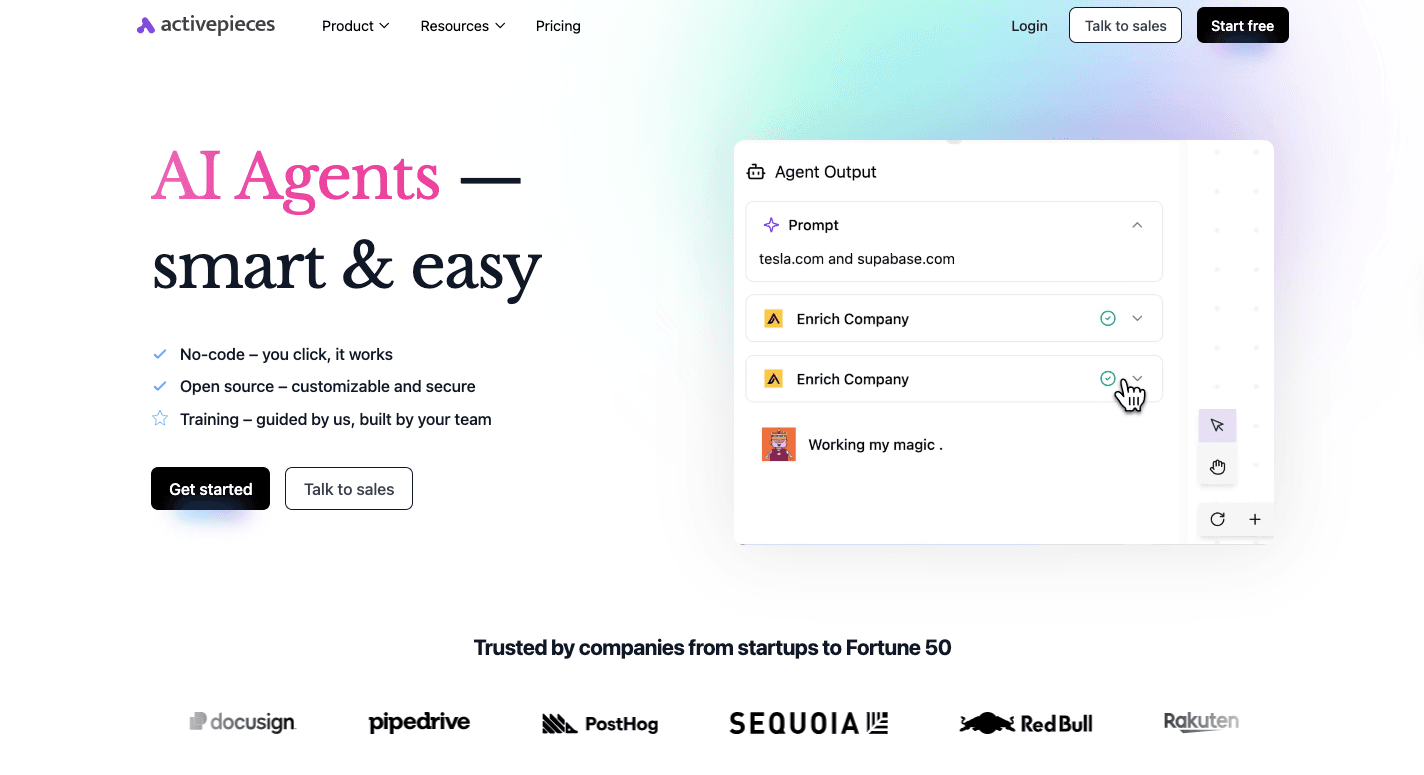
Activepieces gives startups and enterprises a way to run automation without the hassle. Non-technical users can build workflows through an easy no-code builder, while developers can customize every detail with TypeScript.
What makes it even better? The sheer number of connections. With 413+ pre-built integrations, called pieces, you can connect to Microsoft Teams and Slack to OpenAI, Google AI Studio, and CRM platforms like Zoho.
For teams that want to stop spending hours on manual tasks and focus on growth, Activepieces puts marketing, sales ops, support, and internal processes on autopilot while keeping everything connected in one place.
Key Features
- AI-first automation – Build workflows with native AI steps and agents.
- No-code builder – Simple drag-and-drop flows for non-technical users.
- Open ecosystem – Over 413 pieces contributed by the community and developers.
- Developer freedom – Pieces written in TypeScript for full customization.
- Security options – Self-hosted or cloud with enterprise-grade security.
- Human input interfaces – Add approvals, forms, or chat inputs when needed.
- Copilot assistance – AI Copilot guides you through building flows.
Integrations
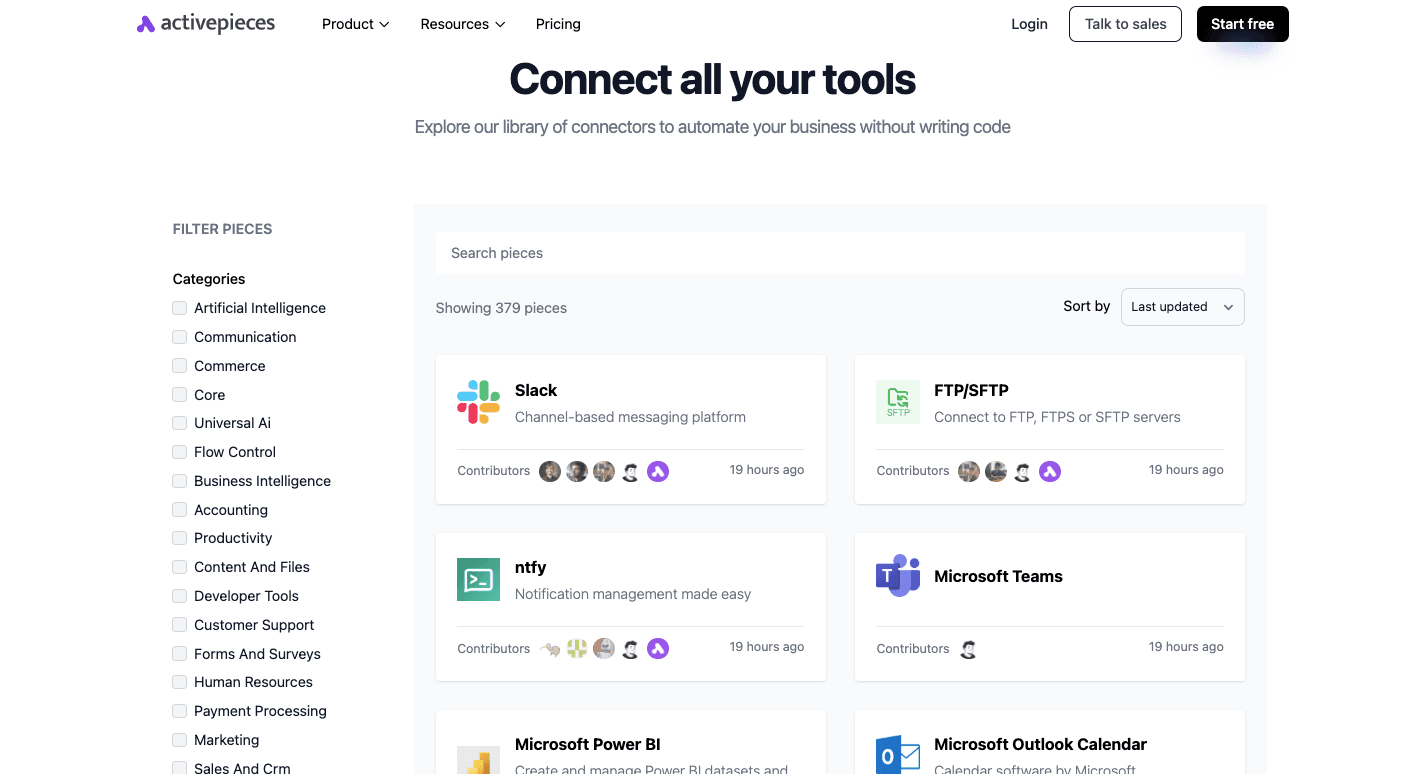
With over 413 pieces, Activepieces connects across categories you rely on:
- AI services: OpenAI, Google AI Studio (Gemini), ElevenLabs
- Productivity: Google Sheets, Excel 365, Slack, Microsoft Teams, ClickUp
- CRM and support: Zoho CRM, Microsoft Dynamics CRM, Zoho Desk
- Marketing: WordPress, ActiveCampaign, Total CMS
- Finance: Zoho Books, Zoho Invoice, Power BI
Since the ecosystem is open, the library grows quickly through community contributions and developers adding new pieces every week.
Use Cases
Activepieces shines wherever repetitive work eats into your schedule:
- Automate email campaigns and SEO reporting.
- Sync CRM data across sales, support, and marketing tools.
- Power customer support with AI agents that handle inquiries instantly.
- Connect marketing analytics into dashboards for smarter decisions.
- Replace manual workflows with intelligent automations in ops, finance, or HR.
Pricing
Activepieces offers a free plan that includes 1,000 tasks each month, AI credits, two active flows, and community support. Paid cloud options:
- Plus ($25 per month) gives unlimited tasks under fair use, ten flows, AI agents, and email support.
- Business ($150 per month) expands to 50 flows, a thousand AI credits, multiple users, and API access.
- Enterprise (custom) provides dedicated resources and support for larger organizations.

There’s also a free, Self-hosted Community Edition with no task limits, giving full control over infrastructure and data. Compared to Zapier, Make, or n8n, Activepieces delivers more without draining your budget.
Join for free and put AI-powered workflows to work!
2. Canva AI: Magic Design for Non-Designers
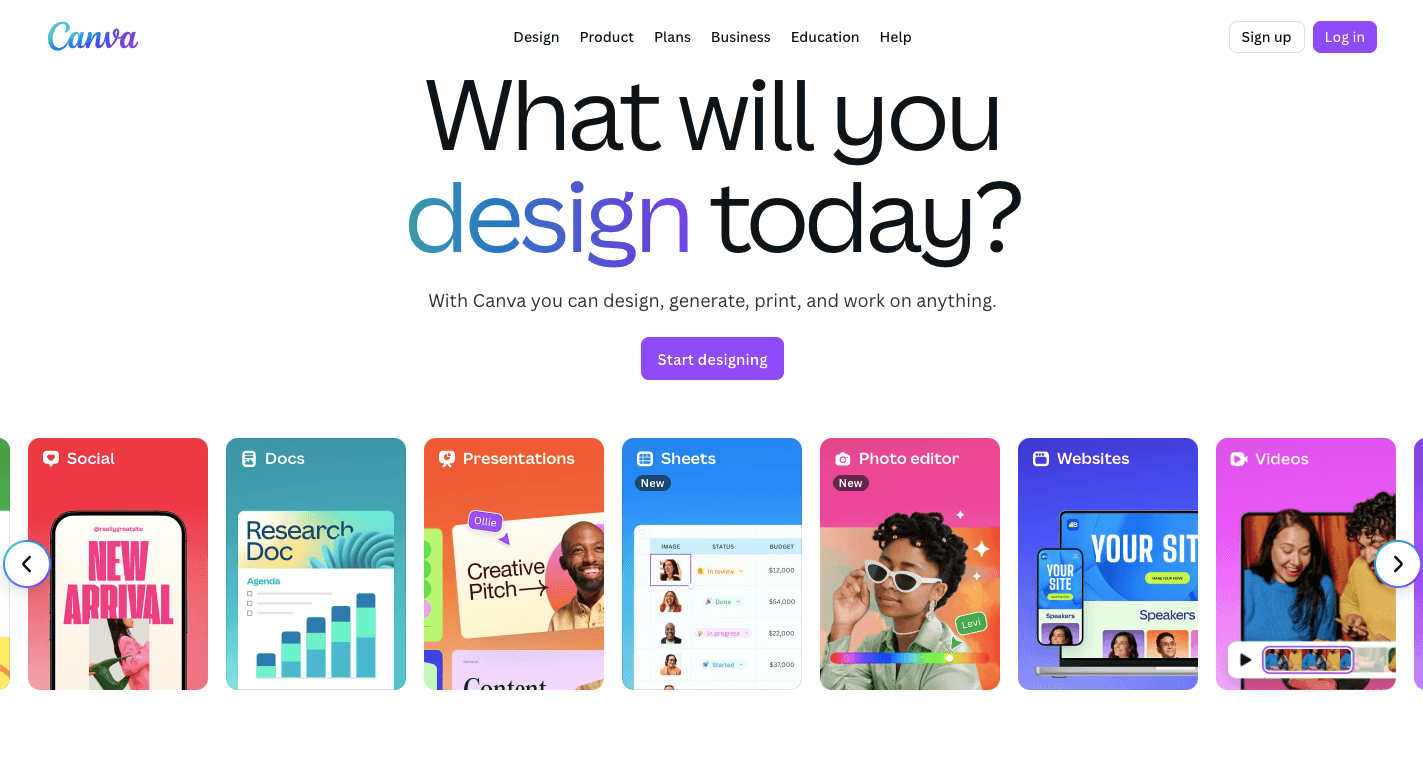
Your startup needs designs, such as a pitch deck, ad campaign, or blog header that look sharp. Through Canva AI, which folds AI-powered features into the Canva editor, anyone on your team can create polished visuals and text in minutes.
You can draft campaign ideas, create digital marketing materials, or build a quick presentation without breaking your flow. Once you’ve finished, Canva lets you share your designs on various social media platforms directly from the editor.
For startups, it speeds up content creation while keeping costs low, which means you can focus on strategy instead of worrying about design.
Key Features
- Magic design – Generates ready-to-use templates from a short description or uploaded file.
- Magic write – Functions as an AI writing assistant for drafting blog posts, ad copy, or emails.
- Magic media – Produces images and video clips in styles like photography, digital art, or 3D.
- Magic edit – Swaps or adds objects in photos with a quick text command.
- Magic grab – Separates the subject from a photo so you can move or resize it.
- Magic eraser – Removes unwanted elements and fills the space with natural backgrounds.
- Magic switch – Adapts a design to new sizes or languages for different channels.
- Magic animate – Adds smooth motion to slides and visuals with a click.
Pros
- Saves hours with fast drafts and edits.
- It operates inside one platform, so there is no need to switch between apps.
- Keeps logos, colors, and fonts aligned with your brand identity.
Cons
- Generic results unless customized.
- Free accounts only get a small number of AI credits.
- Requires strong internet access for smooth use.
Pricing
Canva AI runs inside Canva’s plans, so you don’t pay for it separately. For free accounts, you get a small allowance of Magic Write and Magic Media credits. Pro plans start at $15 per month and include a bigger credit pool, premium stock assets, and 1TB of storage.
Then Teams plans start at $10 per user each month (three users minimum) and add collaboration controls. Meanwhile, Enterprise plans offer custom pricing with advanced support and privacy features.
Students and nonprofits may qualify for free upgrades that include Canva AI.
3. Upmetrics: AI-Powered Business Plan Generator
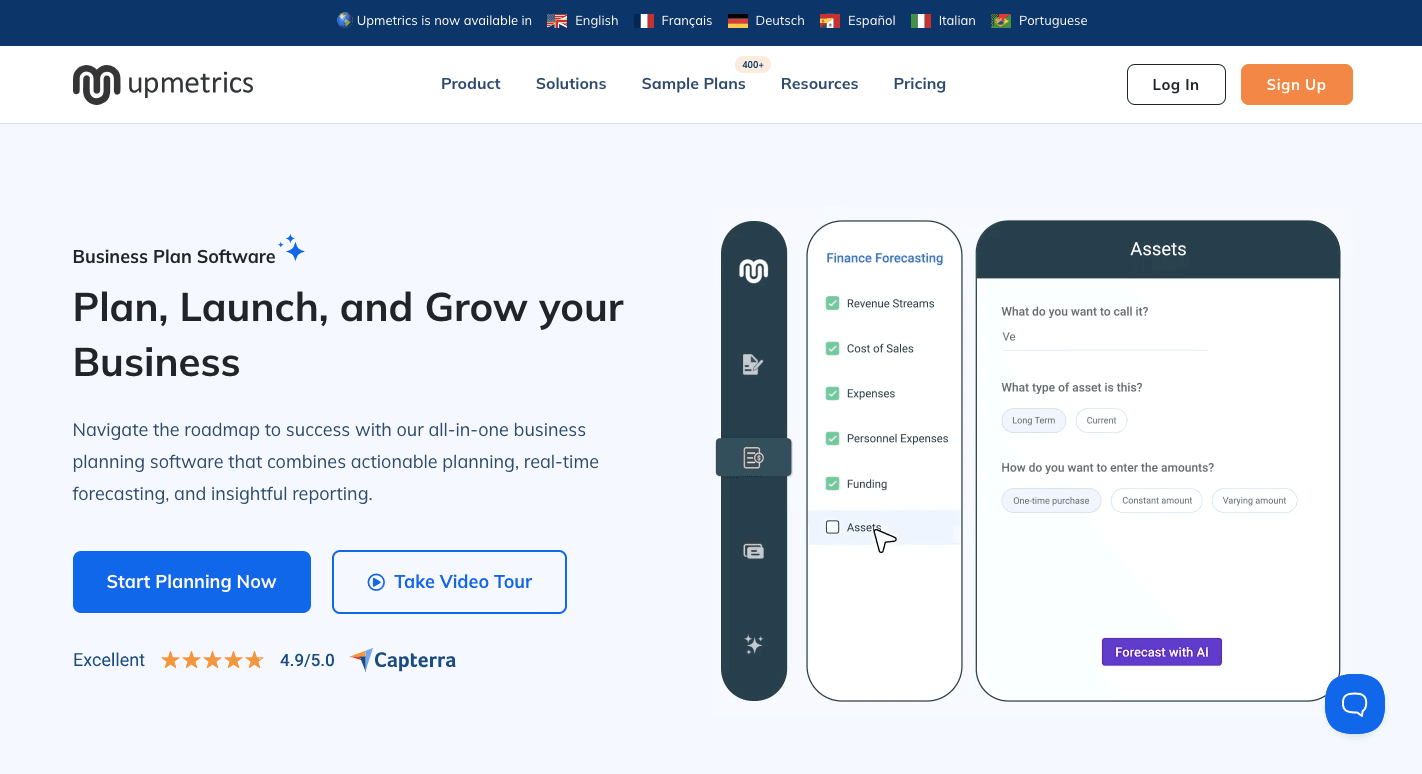
Every startup needs a clear business plan, but building one from scratch takes time and often requires expert help.
Upmetrics changes that by combining templates, guided workflows, and AI-powered features to turn your ideas into a business plan. You can also generate investor-ready pitch decks and financial forecasts in the same workspace.
For founders, you can start by selecting from industry-specific templates. The system then guides you step by step. Once your business plan is complete, you can export it as a PDF, Word file, or even a presentation for investor meetings.
While some may find the AI content generic, the mix of templates, editing tools, and collaboration options makes it dependable for early-stage teams.
Key Features
- AI business plan generator – Produces a first draft by asking simple questions about your idea.
- AI writing assistant – Refines sections with better wording and structure.
- AI financial assistant – Builds forecasts like cash flow and break-even reports.
- AI pitch deck generator – Creates an investor-ready pitch deck directly from your plan.
- Planning templates – Includes Business Model Canvas and Lean Canvas layouts.
- Financial forecasting – Generates profit and loss, cash flow, and balance sheets automatically.
- QuickBooks and Xero integrations – Syncs real data to strengthen financial accuracy.
- Exports – Download your plan or deck in PDF, Word, Excel, or PowerPoint formats.
Pros
- Automated forecasts save hours of manual spreadsheet work.
- A large template library cuts down on research.
- Supports collaboration with secure workspaces.
Cons
- AI text sometimes needs heavy editing to match the brand voice.
- Limited integrations beyond QuickBooks and Xero.
- No dedicated mobile app for working on the go.
Pricing
Upmetrics offers three paid plans. The Starter plan costs $9 per month and includes 400+ templates, a three-year forecast, and one workspace for up to five members.
Premium costs $19 per month and adds AI plan writing, a seven-year forecast, and QuickBooks/Xero integrations. Besides that, Professional runs $49 per month, offering three workspaces, a ten-year forecast, and client management tools.
4. ChatGPT: Generative AI for Any Startup Task
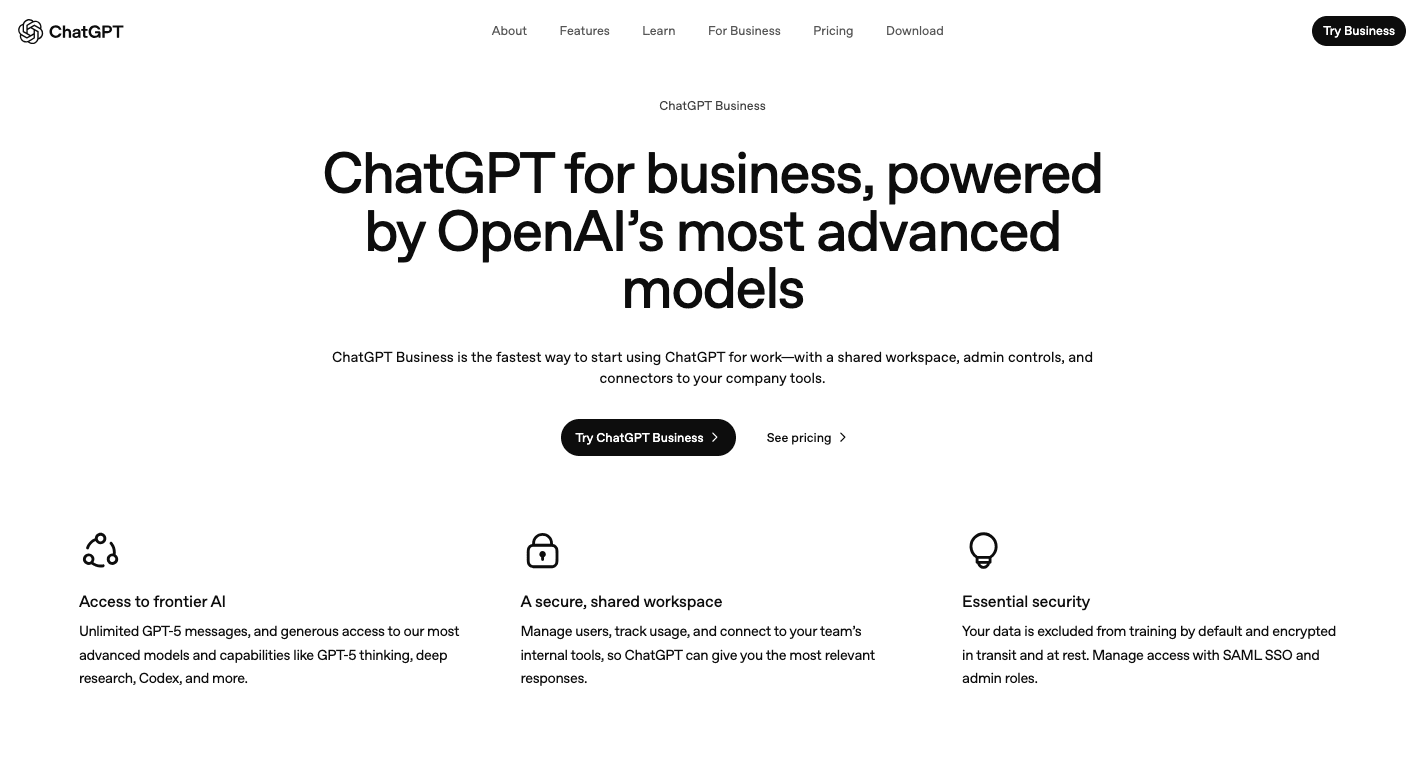
As a generative AI system, ChatGPT drafts emails, explains code, summarizes reports, and brainstorms ideas on demand.
More importantly, it develops social media posts and pitch decks, generates blog posts, and creates compelling content that fits your audience. You can even use it to prepare how-to guides or refine your messaging to match your unique brand voice.
Since ChatGPT operates conversationally, you can ask follow-up questions, request rewrites, or shift the style until the output feels right.
The time you spend on researching and writing even lessens as you use it to generate drafts. And although it still requires human editing, ChatGPT saves time and keeps content flowing.
Key Features
- Natural language processing – Generates clear, human-like responses to prompts.
- Creative writing – Produces stories, outlines, and drafts for blogs or campaigns.
- Multilingual support – Translates text or communicates in several languages.
- Logical reasoning – Breaks down complex questions into step-by-step answers.
- Coding help – Writes and debugs code in multiple programming languages.
- Data analysis – Processes and explains datasets to provide insights.
- Web browsing – Fetches up-to-date information on current topics.
- Image generation – Creates visuals using integrated tools like DALL·E.
- Custom GPTs – Let you design specialized assistants for unique tasks.
Pros
- Handles diverse tasks from code to copy.
- Generates quick drafts for faster workflows.
- Supports brainstorming and ideation.
Cons
- Some outputs sound generic without editing.
- Advanced reasoning remains limited compared to human experts.
- Heavy reliance reduces original thinking and creativity.
Pricing
ChatGPT is available across several tiers. The free plan includes limited access to GPT-5 and features like file uploads, basic image creation, and browsing. _Plus costs $20 per mont_h, offering faster response times and priority access to new tools.
On the other hand, Pro is at $200 per month and offers advanced reasoning and unlimited use. Business costs $30 per user each month and adds enterprise security along with team collaboration features.
For Enterprise, the pricing is custom, with expanded features, dedicated support, and higher usage limits for larger organizations.
5. Grammarly: AI-Powered Writing Assistant
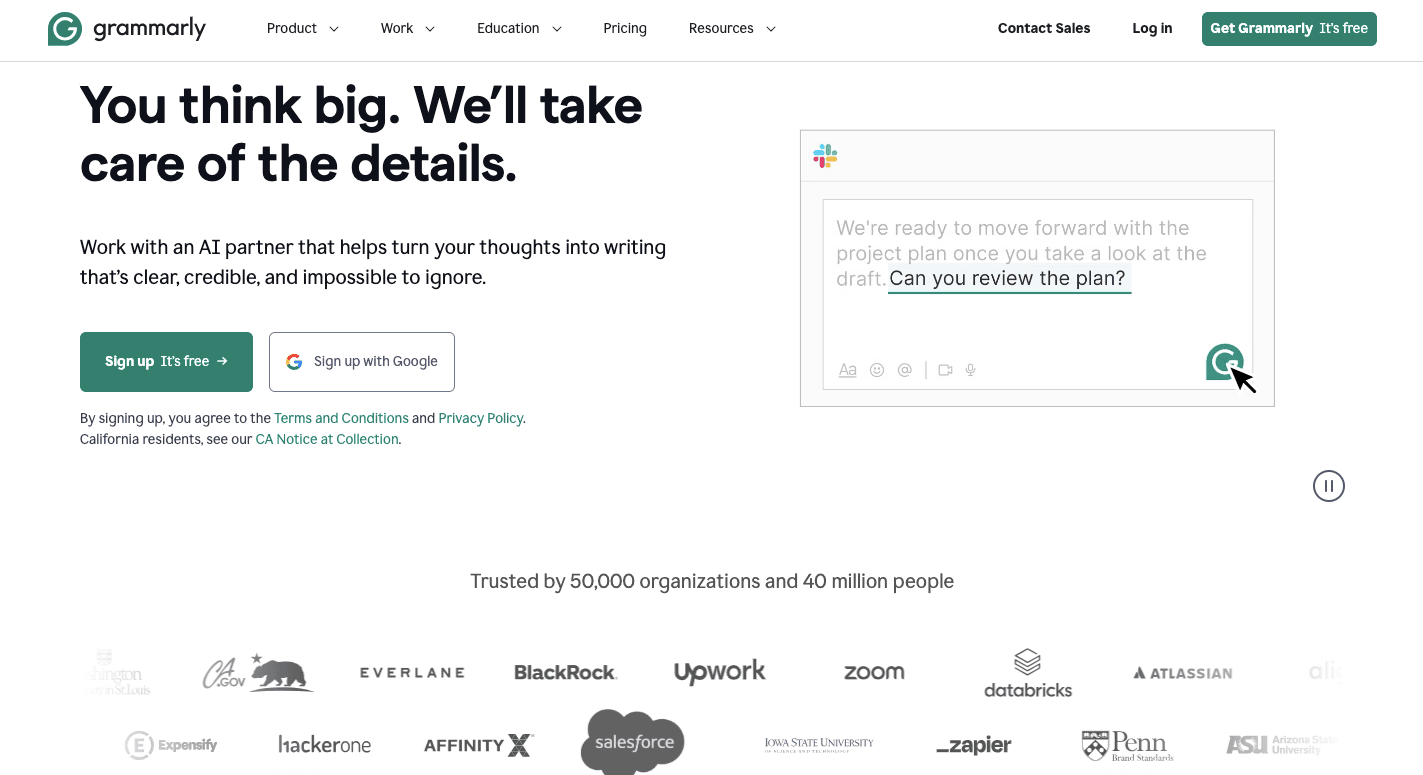
Grammarly steps in as an AI writing assistant that goes far beyond checking spelling and punctuation. It gives real-time suggestions for clarity, grammar, tone, and fluency.
Other than that, it functions as a conversational AI writing tool that adapts to different contexts. You can ask it to refine text for a pitch, expand an idea into long-form content, or shorten sentences for quick updates.
Even without dedicated editors, you can still sound professional every time, as Grammarly supports drafting ads, emails, and posts. You can further use it across Google Docs, Microsoft Office, email, and Slack.
Key Features
- Grammar – Detects and corrects mistakes in real time.
- Vocabulary suggestions – Offers better word choices to sharpen your writing.
- Tone detection – Highlights how your message may sound and adjusts for the audience.
- GrammarlyGO – Generates drafts, rewrites, or expansions with generative AI.
- Email assistance – Suggests responses and summaries directly in email platforms.
- Plagiarism checker – Scans content against billions of sources for originality.
- Custom style guides – Keep team content aligned with your chosen brand voice.
- AI content detector – Flags text that may look AI-generated.
- App integrations – Works seamlessly across thousands of websites and apps.
Pros
- Tone and clarity checks keep writing consistent.
- GrammarlyGO supports creative brainstorming and drafting.
- The plagiarism checker helps with academic or formal writing.
Cons
- Context misinterpretation leads to unnecessary changes.
- Requires internet access for most features.
- Over-reliance may reduce personal editing skills.
Pricing
Grammarly offers a free plan that covers basic corrections and tone detection. Pro costs $30 per member each month and includes sentence rewrites, advanced tone adjustments, unlimited suggestions, plagiarism checks, and 2,000 AI prompts.
Enterprise plan goes further with advanced security, custom permissions, encryption, and unlimited AI prompts.
6. HubSpot AI: Marketing and Sales AI
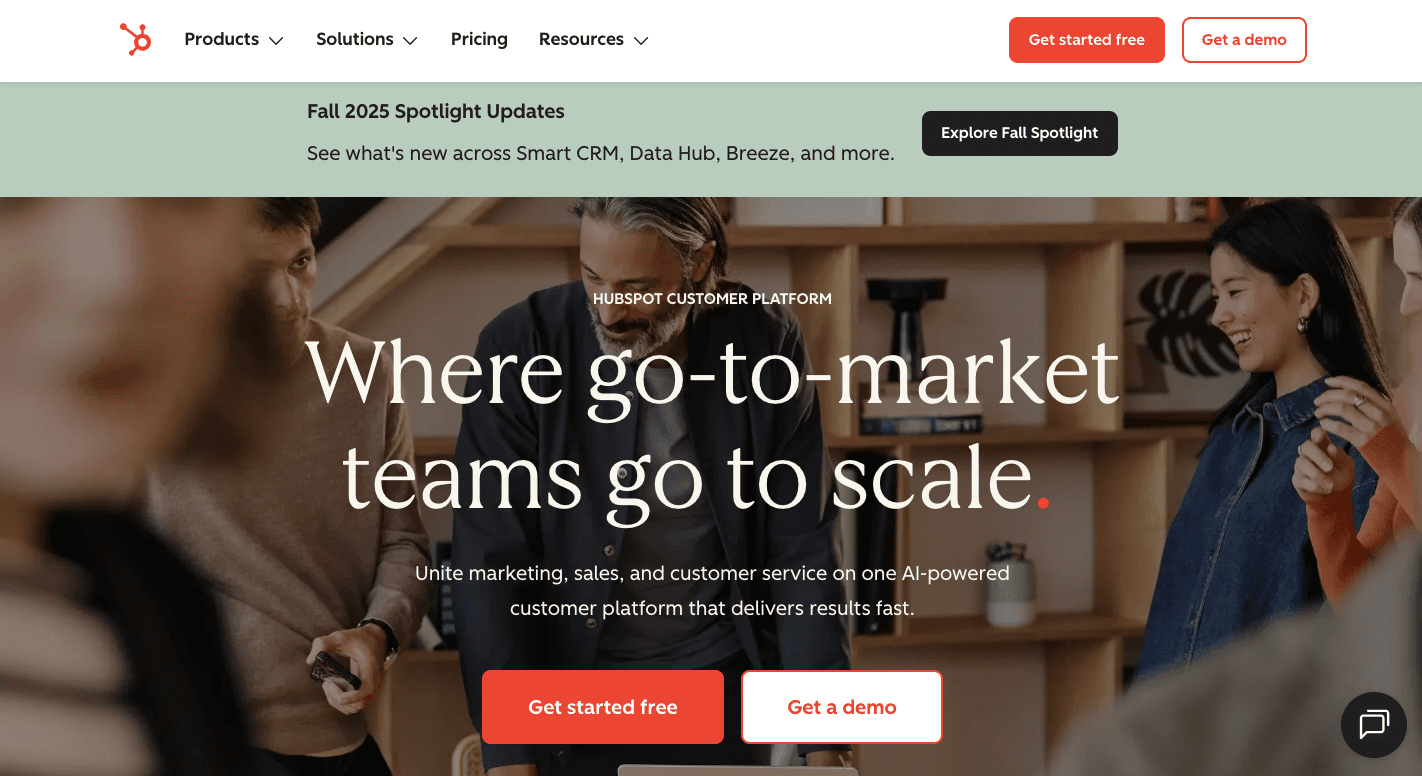
HubSpot AI, known as Breeze, brings intelligence directly into the HubSpot CRM so your team can focus on building relationships.
By working with the data already stored in your CRM, this AI platform helps you write content, respond to leads, and analyze customer data. You also gain reports based on business data that highlight opportunities and support a stronger go-to-market strategy.
Marketers benefit from Breeze’s ability to segment users based on behavior and deliver campaigns that feel personal. Meanwhile, sales teams use predictive scoring to prioritize prospects, and service teams resolve support requests faster with AI-generated summaries.
You can also track metrics across campaigns, sales pipelines, and support interactions to understand what’s driving results in a competitive landscape.
Key Features
- Breeze Copilot – Generates and edits emails, blog posts, and summaries in context.
- Content agent – Produces and repurposes campaign assets.
- Prospecting agent – Researches leads, tracks buyer intent, and drafts outreach.
- Customer agent – Manages incoming questions with CRM-informed replies.
- Breeze intelligence – Forecasts revenue and enriches contact details.
- Conversation assistance – Summarizes calls and suggests responses.
- Social media agent – Creates and schedules audience-focused posts.
- Duplicate management – Cleans contact records for reliable reporting.
- Form shortening – Simplifies sign-ups for known contacts.
- Predictive lead scoring – Flags high-potential leads using machine learning.
Pros
- Provides context-aware insights rooted in company data.
- Automates tasks for marketing, sales, and service teams.
- Generates predictive forecasts to guide planning.
Cons
- Accuracy depends heavily on clean CRM records.
- Feature variety can feel overwhelming for new users.
- Integrations with non-HubSpot tools remain limited.
Pricing
HubSpot AI provides free access to an AI content writer, website builder, and conversation summaries. Paid plans unlock more advanced agents and forecasting features. Starter subscriptions begin at $15 per seat each month.
Professional plans expand AI use across hubs: the Marketing Hub starts at $890 per month for three seats, while Sales Hub and Service Hub each cost $100 per seat monthly.
7. Front: Collaborative Customer Service
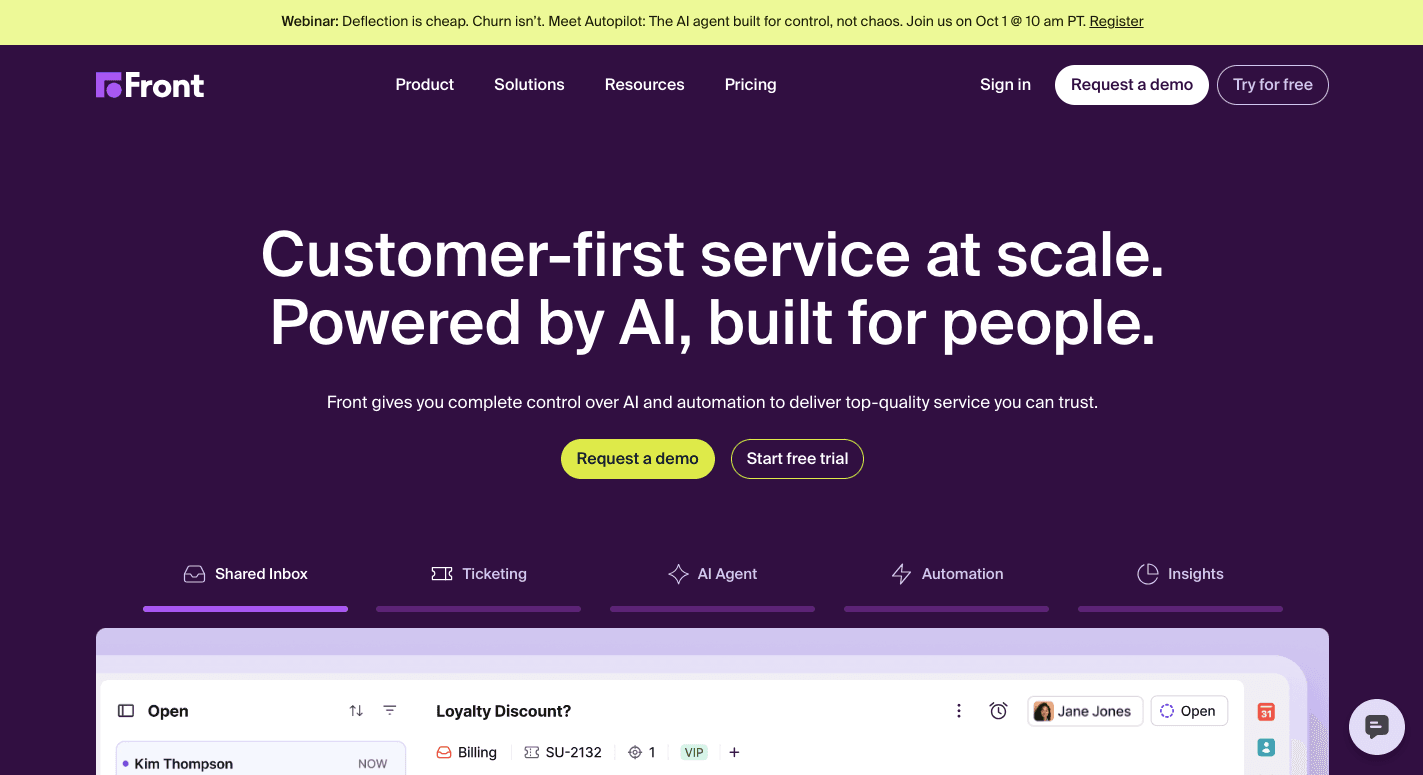
Your startup grows by building strong relationships, and that means every conversation counts. Front manages those moments by uniting email, chat, SMS, and social media into one shared inbox.
The platform makes it easy to resolve customer inquiries quickly and coordinate with your team in real time.
Every message carries context, so your teammates see the full history of customer interactions without searching through old threads. You can assign conversations to the right person, leave private notes, or draft replies together.
Front combines automation with team collaboration tools that save time while keeping communication personal. Startups in any target market can use it to keep customer conversations organized and on-brand.
With automation layered in, repetitive tasks like tagging, routing, and SLA tracking are handled behind the scenes.
Key Features
- Omnichannel inbox – Centralizes email, chat, SMS, and social channels.
- Shared inboxes – Assign messages and track ownership.
- Real-time collaboration – Leave comments, share drafts, and @mention teammates.
- AI assistance – Suggests replies and handles simple questions.
- Workflow automation – Routes and tags conversations automatically.
- Knowledge base – Provides self-service content for customers.
- Ticketing tools – Manages complex support issues.
- Analytics and dashboards – Measure response times and team performance.
- App integrations – Connects with CRMs, project management tools, and chat apps.
- Mobile access – Manage communications on iOS and Android devices.
Pros
- Consolidates channels into one inbox.
- Improves accountability by assigning ownership.
- Provides analytics for team performance and customer satisfaction.
Cons
- Performance issues can occur with long threads.
- Mobile app lacks the depth of the desktop version.
- Integrations with external apps may feel limited.
Pricing
Front offers three tiers. The Starter plan costs $35 per seat monthly and includes shared inboxes, ticketing, basic analytics, and limited automation.
Professional costs $85 per seat each month for up to 50 users, adding omnichannel support, macros, advanced analytics, and multiple workspaces. Enterprise is available with custom pricing.
8. Runway ML: AI-Powered Video Editing
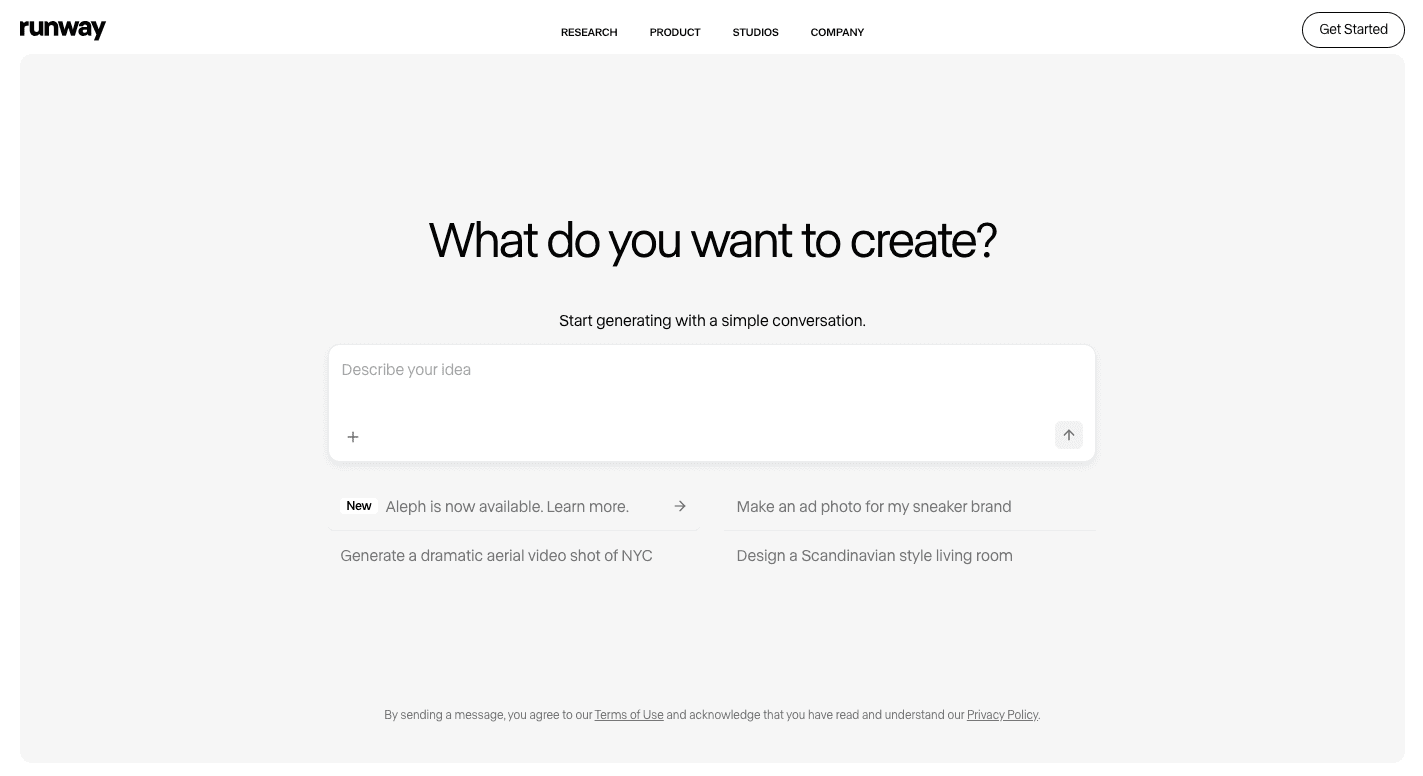
How much time do you and your team spend editing videos? As startups, that often means long nights piecing clips together, fixing backgrounds, and trying to make content look professional.
Runway ML includes advanced machine learning algorithms that handle video editing automatically, so you don’t have to spend hours tweaking frames. Since it lives in the cloud, you don’t need high-end computers to run it.
You type what you want, upload an image or clip, and the platform generates or edits a video that fits your idea. For early-stage companies, this makes it possible to produce content that matches your vision without hiring a large team.
Multiple people in your marketing team can also log in, edit the same project, and share files in real time.
Key Features
- Text-to-video – Type a prompt and watch it turn into a short video.
- Image-to-video – Animate still images with motion.
- Video-to-video – Restyle or enhance existing clips.
- Motion brush – Add movement to a chosen part of an image.
- Inpainting – Erase unwanted objects and replace them.
- Background removal – Swap or clear video backgrounds automatically.
- Color grading – Adjust tone and style with simple prompts.
- Scene detection – Split longer videos into separate clips.
- Lip sync and audio tools – Match audio with your video characters.
Pros
- User-friendly for beginners and pros.
- Saves hours on editing tasks.
- Produces high-quality results with its latest models.
Cons
- Some advanced features take practice to master.
- Generated clips can be inconsistent.
- An internet connection is required to use it.
Pricing
Runway ML starts with a free plan that offers 125 one-time credits, though you’ll see watermarks and slower processing. The Standard plan costs $15 per month, with 625 monthly credits and 100GB of storage.
Pro is $35 monthly with 2,250 credits and more advanced options. Unlimited is $95 per month and opens up endless generations in Explore Mode. For large-scale teams or agencies, Enterprise plans are custom-built with expanded resources and dedicated support.
9. Notion AI: Knowledge Management and Documentation
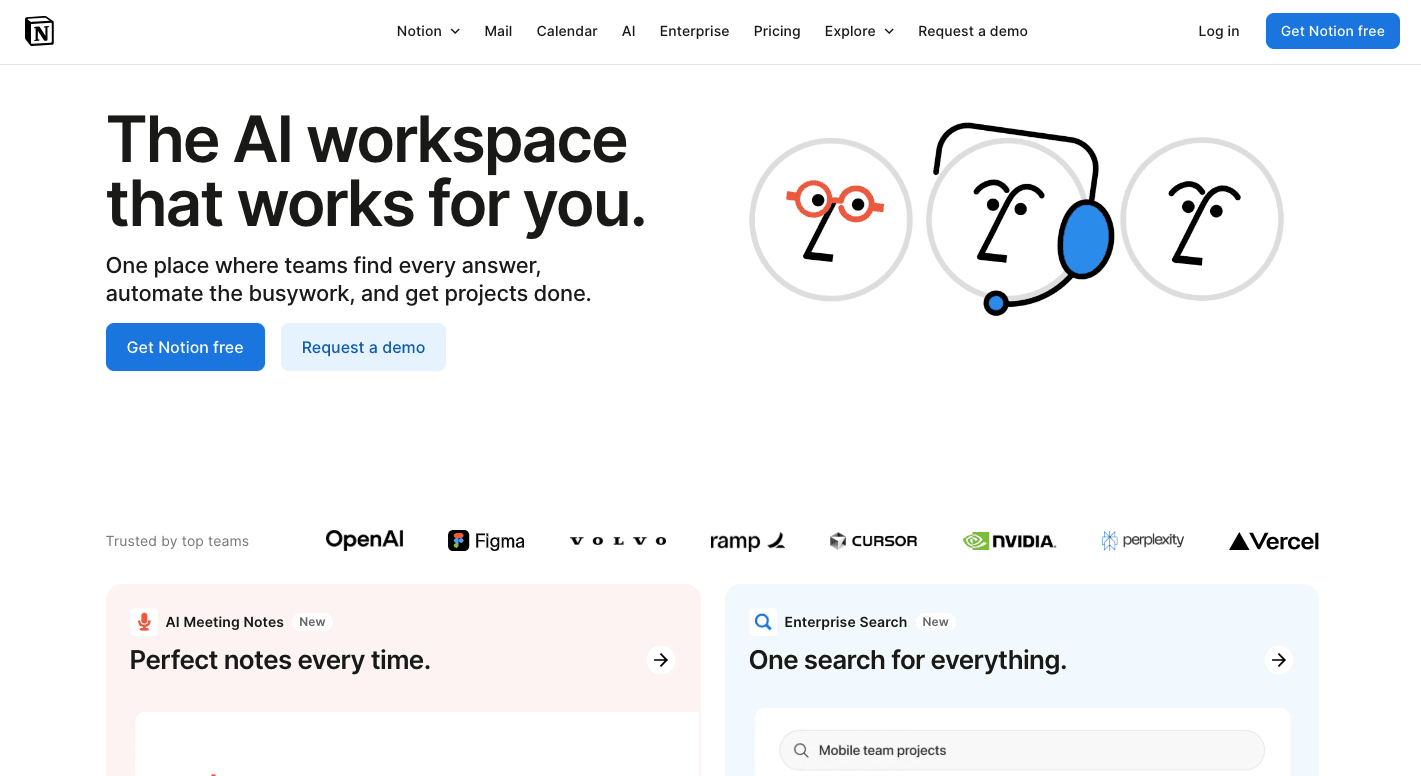
Notion AI helps you create drafts, summarize pages, and answer questions based on your own data.
You can ask questions and get answers pulled from your workspace, connected apps, or even findings from market research. Over time, this makes it easier for startups to organize internal knowledge and reduce wasted effort.
The platform also supports collaboration. Teams can edit in real time, assign tasks, and link databases for better project management.
For founders who want a single place to manage ideas, tasks, and documents, Notion AI combines smart assistance with the flexibility of an all-in-one workspace.
Key Features
- Draft content – Generate blog posts, emails, or agendas from prompts.
- Rewrite and edit – Shorten, expand, or adjust tone to fit your needs.
- Summarize documents – Turn long pages into quick, digestible points.
- Q&A search – Ask natural-language questions and get answers from your workspace.
- Database automation – Autofill properties or generate structured entries.
- Enterprise search – Scan across Notion and connected apps for context.
- Translation – Convert documents into other languages instantly.
- Research mode – Compile findings from your workspace and the web.
- AI connectors – Pull in content from tools like Slack, Google Drive, and GitHub.
Pros
- Generates drafts, summaries, and translations without extra tools.
- Enhances knowledge management with natural-language search.
- Privacy commitments protect company data.
Cons
- Requires an additional subscription.
- Large workspaces may feel slow or heavy.
- General-purpose design may not satisfy specialized use cases.
Pricing
Notion AI is available as an add-on across plans. The free plan includes core workspace features for individuals. Plus costs $12 per member per month and adds unlimited blocks, uploads, and integrations.
The Business plan is priced at $24 per member per month, and it includes SAML SSO, private teamspaces, and premium integrations. Enterprise offers custom pricing, designed for larger teams needing advanced controls and security.
Give Your Startup an AI Assistant Edge With Activepieces
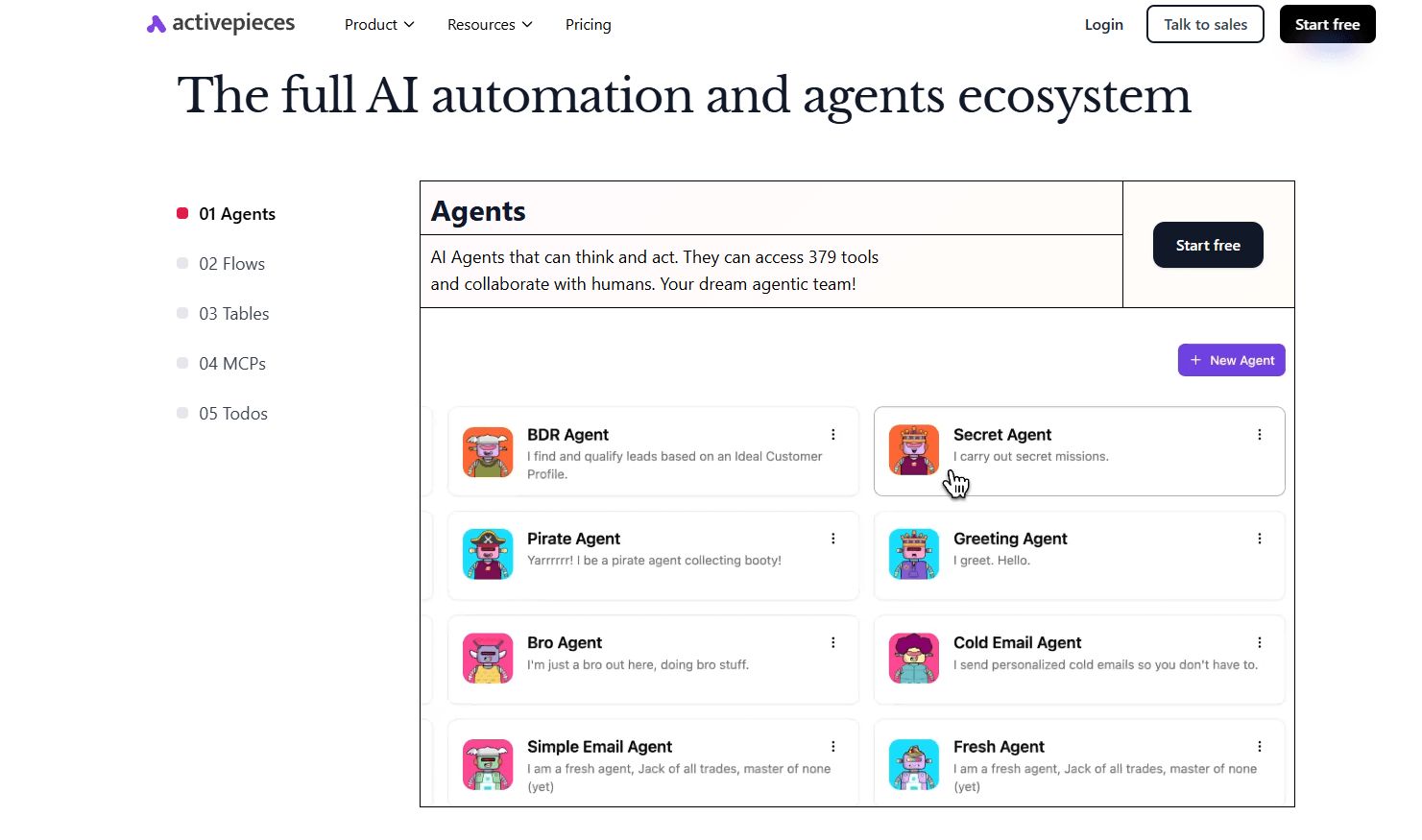
Activepieces works as a full-time AI assistant that handles your email campaigns, SEO workflows, sales operations, and customer support.
The experience is smooth for non-technical teammates who want to build automations quickly, and it offers TypeScript for developers who want to go deeper.
There are 413+ integrations (called pieces). Since over half of the pieces come directly from the community, the library grows quicker than closed competitors and reflects what real startups actually need.
You can self-host to keep data under your control or use the cloud version with enterprise-level protection. Activepieces also gives you features like “human-in-the-loop” for approvals and chat or “form interfaces” for moments when people need to guide the process.
Compared with Zapier and n8n, Activepieces is more like the automation and AI hub your entire business can trust.
Connect with sales and discover how Activepieces fits your stack!
FAQs About AI Tools for Startups
How can startups use AI?
Startups use AI to generate actionable insights, improve customer service through automation, optimize sales processes, enhance marketing strategies, and unlock customer insights with conversation analytics, data analysis, performance analytics, and built-in analytics.
Many AI tools are available to help teams operate more efficiently and scale faster, and they can build their AI startup on Google Cloud for reliable infrastructure and scalability.
What are the four types of AI tools?
The four types of AI solutions are machine learning platforms, natural language processing tools, robotics, and expert systems.
What is the easiest AI tool for beginners?
The easiest AI tool for beginners is Activepieces, since it offers a no-code builder, over 413 integrations, and AI-native features that make automation for startups simple.


